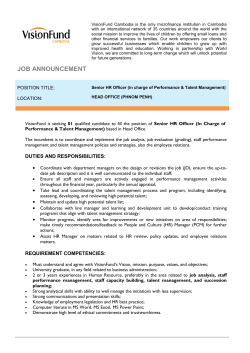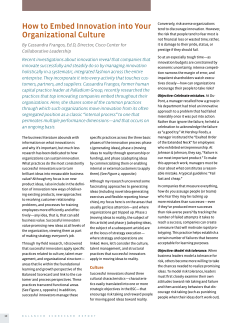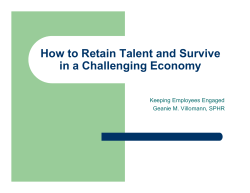
Redesigning Knowledge Work by Martin Dewhurst, Bryan Hancock,
HBR.ORG Spotlight on The Future of Knowledge Work January–February 2013 reprinT R1301C Redesigning Knowledge Work How to free up high-end experts to do what they do best by Martin Dewhurst, Bryan Hancock, and Diana Ellsworth Spotlight on The Future of Knowledge Work Spotlight Artwork Jules de Balincourt Untitled (Merging Kissers) 2011, oil on panel, 78" x 58" x 2.5" For article reprints call 800-988-0886 or 617-783-7500, or visit hbr.org Martin Dewhurst is a director in McKinsey & Company’s London office. Bryan Hancock is a principal in the Atlanta office. Diana Ellsworth is an engagement manager in the Atlanta office. Redesigning Knowledge Work How to free up high-end experts to do what they do best by Martin Dewhurst, Bryan Hancock, and Diana Ellsworth January–February 2013 Harvard Business Review 3 E Spotlight on The Future of Knowledge Work Experts with prized skills are too rare to squander on jobs others can do. That’s why some organizations are relieving their valuable talent of those responsibilities so that they can spend more time on the tasks only they can perform—by redesigning job roles within the company or by turning to external providers of specialized expertise. Consider these examples: • Orrick, Herrington & Sutcliffe, a San Francisco– based law firm with nine U.S. offices, shifted routine discovery work previously performed by partners and partner-tracked associates to a new service center in West Virginia staffed by lower-paid attorneys. • The Narayana Hrudayalaya Cardiac Hospital in Bangalore has junior surgeons, nurses, and technicians handle routine tasks such as preparing the patient for surgery and closing the chest after surgery. Senior cardiac surgeons come to the operating room only when the patient’s chest is open and the heart is ready to be operated on. This approach helps the hospital provide care at a fraction of the cost of U.S. providers while maintaining U.S.-level mortality and infection rates. • In the United Kingdom, a growing number of public schools are relieving head teachers, or principals, of administrative tasks such as budgeting, human resources, facilities maintenance, and community relations so that they can devote more time to developing teachers. In today’s knowledge economy, competitive advantage is increasingly coming from the particular, hard-to-duplicate know-how of a company’s most skilled people: talented (and highly paid) engineers, salespeople, scientists, and other professionals. The problem is that across the private, public, and social sectors there aren’t enough knowledge workers to go around. And the situation promises to get worse: Recent research by the McKinsey Global Institute suggests that by 2020 the worldwide shortage of highly skilled, college-educated workers could reach 38 million to 40 million, or 13% of demand. In response, some firms are taking steps to expand the talent pool—for example, by investing in apprenticeships and other training programs. But a number of companies are going further: They are redefining the jobs of their experts, transferring some of their tasks to lower-skill people inside or outside their organizations, and outsourcing work that requires scarce skills but is not strategically important. Such moves aren’t new, of course. Firms have long been carving off repeatable, transactional work—such as call center services, payroll, or IT sup- 4 Harvard Business Review January–February 2013 port—and either shifting it to lower-cost locations or outsourcing it. What is new is that companies are now doing this with knowledge-based jobs that are core to the business. In the past five years, we have worked with or studied more than 50 companies in a wide range of industries on talent management issues. We found that redefining high-value knowledge jobs not only can help companies address skills shortages. It also can lower costs and increase job satisfaction. Some organizations are already familiar with ways to break work into highly specialized pieces. In this article, we’ll show how to do that for high-end knowledge work. The process involves several basic steps: identifying the gap between the talent your firm has and what it will need; creating narrower, more-focused job descriptions in areas where talent is scarce; choosing from various options for filling the skills gap; and rewiring processes for talent and knowledge management. Identify the Skills Gap The first step in redesigning knowledge work is to conduct an inventory of skills and create a detailed estimate of the kinds and amounts of skills your firm will need to execute its strategy over the next five years or more. This will require a thoughtful discussion among top managers, leaders of business units, and HR team members, and should be part of the strategic-planning process. We’ve found that many companies don’t have this conversation. They simply reuse the job descriptions already embedded in their organizational chart, year after year, and become alert to the need for new skills only when they find themselves having to play catchup to more-prescient competitors. Companies must be explicit and precise in defining their must-have skills. Here are some illustrations: • A multichannel retailer may determine that to beat online competitors, it will need not only consumer-insight experts with the analytical skills to mine vast amounts of consumer data but also marketing specialists who can build a brand using social media. • A professional services firm may require deep expertise in certain industry-specific niches to address the needs of its clients—for instance, capabilities in credit-risk modeling for financial institutions or patent law for semiconductor manufacturers. • A consumer goods company may discover that it needs a cadre of general managers and marketers Copyright © 2012 Harvard Business School Publishing Corporation. All rights reserved. For article reprints call 800-988-0886 or 617-783-7500, or visit hbr.org Idea in Brief A worsening shortage of high-skill knowledge workers is one of the biggest challenges facing organizations. These talented and highly paid experts—doctors, lawyers, engineers, salespeople, scientists, and other professionals—are companies’ most valuable assets. with proven track records in emerging markets to maximize its potential in geographies projected to account for more than 50% of world economic growth over the next decade. • A pharmaceutical firm, in light of the intensive data analytics now involved in that industry, may need more bioinformatics experts with both scientific and technology expertise. After identifying the critical skills your strategy will require, create a detailed inventory of how many people in your organization possess them. Then estimate how those numbers will change over the next five years given the current pace of hiring, training, moves, and retirement. This analysis typically demonstrates that demand is higher than expected—and that the likely supply (at least internally and potentially externally) will fall short without significant action. Such skills gaps can put key strategies at risk. For example, one global construction company we worked with discovered that it had only a third of the experienced leaders it needed to execute its strategy in China. Unfortunately, many companies do not rigorously document their employees’ specialized skills in either hiring or annual performance-management processes. One financial services firm whose market position was slipping wanted to staff its marketing department with people who could think strategically. It suspected that such strategic thinkers already worked in different parts of the organization, but that skill was not explicitly listed in job descriptions. HR staffers realized that to identify credible candidates they would have to comb through every employee’s performance evaluations and read between the lines. Precision in identifying the must-have skills is crucial. An airline may underappreciate its current talent pool if it defines its scarce skill as “revenue management” rather than “generating insights from large data sets.” The latter is likely to be an under- In response, some firms are redefining the jobs of their experts, transferring some of their tasks to lowerskill people inside or outside their organizations, and outsourcing work that requires scarce skills but is not strategically important. Redesigning jobs in this fashion involves several basic steps: identifying the gaps between the talent your firm has and what it will need; creating narrower, more-focused job descriptions in areas where talent is scarce; choosing from various options for filling the skills gap; and revamping talent- and knowledge-management processes to accommodate the new way of working. lying skill present in many areas of the company, including marketing and operations planning. One mining company we worked with developed detailed descriptions for every key role, specifying not only job responsibilities but also the required skills (“ability to understand financial models”), competencies (“leadership courage”), and mind-sets and behaviors (“strong sense of purpose in initiating difficult conversations”). Some companies now focus on competencies rather than tasks in employee evaluations. Two people in the same role, when evaluated solely on tasks, could both be high performers but might have different underlying competencies; conversely, two people in very different roles might have the same underlying competencies. Their competencies have implications for what their career paths could be and where the organization could best use them today and five years down the road. Analyze How Skills Are Utilized Once your company has identified its talent gaps, it must then determine the workforce implications: Should current and future roles be restructured? How should recruitment, hiring, and training change? What new talent sources, if any, should be considered? Begin by assessing how effectively your company is leveraging existing talent. That will provide insights into how it might better utilize scarce experts. A number of tools can be used to do this: Time allocation surveys, in which people document how much time they spend on tasks, can produce eye-opening results. Companies often find that highly skilled people are spending significant amounts of time on general management or administrative activities that don’t require their scarce skills. A retail bank, for example, discovered that its salespeople were spending a mere 25% of their time January–February 2013 Harvard Business Review 5 Spotlight on The Future of Knowledge Work One organization that has embarked on an ambiselling and the rest on administrative work, such as rewriting contractual documents and processing or- tious program to do this is the division of the United Kingdom’s National Health Service that serves ders, and other activities. Social network analysis, a quantitative London. In its quest to make the most of scarce remethod for surfacing and depicting informal inter- sources, NHS London took a close look at the entire actions among people in an organization, can show “patient journey” through its system, including the locations where patients receive care, the practices which individuals are sought out for different types that have led to the best patient outcomes, and the of expertise and how they are connected to others skills required to deliver high-quality care. Through in the company who need their skills. A professional interviews, observations, and time allocation surservices firm we worked with discovered that only veys, the leaders of the effort identified opportuthree people in one of its largest divisions controlled access to experts whom many in the firm relied on, nities to redesign roles. For example, to ensure that specialist doctors and general practitioners at constraining them from working effectively with the independent providers could focus more on the broader business. tasks that they alone could do, NHS London recommended that the local NHS trusts shift some of their clinical and administrative responsibilities to nurses, paramedics, and assistant practitioners. To smooth transitions into the redesigned roles, NHS London created new training programs for both clinicians and the senior managers who would lead the change. In redefining jobs, companies should also consider technological advances that make it easier to perform work remotely. Companies and employees today have more choices for where work is done and by whom. In cases where in-person interactions and sophisticated judgment are core to value delivery— performing medical procedures, sales, and giving financial advice fall into this category—the goal is to Analysis of outcomes or value can be used to redesign the role so that people are spending all their quantify the effectiveness of any given contributor or process. Some companies use assessment sur- time at the high end of their skill set. If tasks are appropriately segmented, a lower-cost veys to determine whether experts feel their skills are well matched to their current roles and to under- solution shouldn’t mean inferior quality work. When stand how colleagues perceive experts’ performance. a provider of data storage and management solutions we worked with separated sales and post-sales supOther companies evaluate the process for getting to port tasks, it freed up key personnel to spend more an end product. (For a marketing department, an end product could be a brand plan.) The analysis in- time selling—and it allowed the company to provide better customer service after the sale, increasing cusvolves mapping the current process and figuring out the time it takes and its cost; assessing the actual ver- tomer satisfaction. Consider the following options for disaggregating tasks: sus aspired-to quality of the end product; identifying the people deployed at each step of the process; and Virtualization. Tasks that require scarce skills using that information to identify opportunities to but do not depend on in-person interaction or physisimplify the process and ensure a good match be- cal proximity—screening mammograms or conducttween skills and tasks. ing complex pricing analytics, for example—can be shifted to people in less costly locations. This is happening in the U.S. legal industry, Redefine Jobs where clients are increasingly questioning the traUsing the results of a skills-gap analysis, your comditional full-service model of lawyers who charge pany can redefine jobs to ensure that experts devote almost all their time to tasks that require their spe- $300 an hour or more for their time, regardless of the task. For instance, fewer companies are willing cialized skills. Tasks that require scarce skills but do not depend on in-person interaction can be shifted to people in less costly locations. 6 Harvard Business Review January–February 2013 For article reprints call 800-988-0886 or 617-783-7500, or visit hbr.org What Knowledge Work Should You Outsource? Yes Yes Do we have enough in-house experts to handle the current and projected workload? Yes NO Does this expertise represent a source of competitive advantage? Is talent readily available in the market? NO NO Is there an advantage to outsourcing the work? For example: EFFICIENCY (Can productivity be improved by shifting tasks to workers in complementary time zones?) FLEXIBILITY (Is the work related to spikes in demand or onetime projectspecific requirements?) COST (Can tasks be shifted to locations that have lower labor costs?) CAPABILITY (Does the work require expertise gained through serving multiple companies?) to pay high hourly fees for routine discovery work. In response, more law firms are shifting such tasks to lower-cost employees, some of whom are located remotely. As we mentioned above, Orrick shifted discovery work to a service center staffed with salaried attorneys who aren’t on a partner track, which has allowed the firm to significantly lower costs without sacrificing quality. Other law firms send discoveryrelated tasks to attorneys who are employees but work from home and charge lower rates in exchange for flexibility. Regardless of how a company chooses to virtualize work, a performance management system is crucial to success. Performance of individuals who work remotely should be regularly reviewed. Managers may need training to do this effectively. A U.S.-based cable company, for instance, created a program for supervisors of remote employees that teaches them how to manage results, not activities. Outsourcing or contracting. When a company has a onetime or infrequent need for expertise (an oil company needs a certain type of engineer for a specific project or an auto parts firm needs special- OFF-load Low-skill tasks Ensure the most efficient use of scarce experts by peeling off low-skill tasks from experts’ job descriptions and transferring them to lower-cost workers or locations. Recruit and Hire Attract and retain additional experts by opening offices in key hubs and offering top-notch technical training and clear career paths. Train and Develop Create training programs to up-skill current or new employees, leveraging internal or external experts to help build capability. Yes Outsource Partner with outside expert providers, making sure to develop explicit mechanisms for onboarding, project communication, and handing off of work. NO Keep work in-house Off-load low-skill tasks from experts to ensure that almost all their time is spent on work that requires their specialized skills. ized expertise to develop a pricing model) or when a firm experiences periodic surges in demand for certain skills, hiring an external provider could be the best option. In recent years, the availability of highly capable “knowledge professionals on call” has increased. In making the decision to outsource, organizations should consider strategy as well as cost: Does having direct ownership of the work confer any competitive advantage? If so, keep that work in-house and make sure that those responsible for the work are freed from lower-value tasks that others could accomplish. If a company does decide to outsource, it must take pains to connect its external providers to the broader organization. This starts with an orientation or onboarding program that gives contractors an insider’s understanding of the firm and provides them with points of contact. The company must facilitate frequent interaction and communication between contractors and internal experts and decision makers, and establish a well-thought-out process for the handoff of work to internal owners. January–February 2013 Harvard Business Review 7 Spotlight on The Future of Knowledge Work take on broader roles or become leaders in the organization. A telecommunications firm we worked with created a job-rotation program that allows highperforming specialists in remote offices to spend a few months at corporate headquarters, where they can get exposure to senior executives and expand their knowledge of the company. A U.S.-based financial firm monitors the performance of analysts at low-cost offshore locations who produce basic reports for its traders at company operations in the U.S., Europe, and Asia. Top performers are identified and developed to take on higher-skill trading roles. Third, companies must capture the knowledge of internal and external specialists so that others in the organization can benefit from it. This requires robust, easy-to-use knowledge management processes and systems. Some companies categorize each project up front according to the insights it is likely to generate (for example, “distinctive,” “proprietary,” or “common”) and create a road map for how insights should be documented and shared. The road map specifies templates for codifying knowledge, lists of people and groups within the company who might find the knowledge useful, and suggested schedules fell flat; they were seen as “interesting” but disconfor knowledge-transfer meetings. nected from the overall sales strategy—especially Fourth, companies should ensure that specialist since an internal group at the retailer had undertaken employees working remotely engage with both the similar but less sophisticated analytics and reached employees who use their work and business leaders. different conclusions. Had the executive linked the Ways to make this happen include inviting them to analytics firm more closely to people in the business join cross-functional teams, having company leadwho had historically set pricing strategy or had he ers meet with specialist groups regularly, and embriefed the contractors about the company’s broader bedding specialists in business units. business strategy and objectives, the project would As with any major workforce change, it’s often have delivered much greater value. best to start small: Move one subset of work to specialists or external providers and expand that base Rewire Processes for Talent and over time. This allows a company to test new talent Knowledge Management pools and management processes and build stakeThe solutions we’ve described will be effective only if an organization also retools its processes and cul- holders’ confidence in them. ture to support the new ways of working. In parAggressive companies are shaking off conventions ticular, firms must learn how to manage specialists about where, how, and by whom knowledge work and external providers and integrate them into the is done. But as traditional roles are redefined, workbusiness. First, companies must excel at attracting, moti- ers are bound to struggle with uncertainty. It’s crucial that leaders redouble their efforts to ensure that vating, and retaining specialists. Some large retailers such as Walmart and Staples are luring tech talent, key managers are fully engaged. All employees must understand how the transformation is connected to for instance, by opening offices in technology hubs like Silicon Valley and Cambridge, Massachusetts, them, know what is expected of them, and be clear on how their success will be evaluated. In this way and by offering top-notch technical training and they can unlock both increased productivity and perclear career paths. sonal satisfaction. Second, companies must develop mechanisms for cultivating specialists who have the potential to HBR Reprint R1301C Without those mechanisms in place, external providers may produce work that is technically accurate but lacks company-specific nuance or the internal buy-in necessary for it to stick. A case in point: A midlevel executive at a large retailer contracted with an analytics firm in India to run detailed analyses to inform the retailer’s pricing strategy. The firm produced high-quality technical work, but when the results were shared with senior management, they Aggressive companies are shaking off conventions about where, how, and by whom knowledge work is done. 8 Harvard Business Review January–February 2013
© Copyright 2025





















